| Reprinted with permission from: Rhinehart, Richard, 2005, Without a Trace: Elephant Mountain's Secrets Revealed:
Rocky Mountain Caving, Colorado Grotto, v. 22, n. 2, Spring 2005, p. 16-21. |
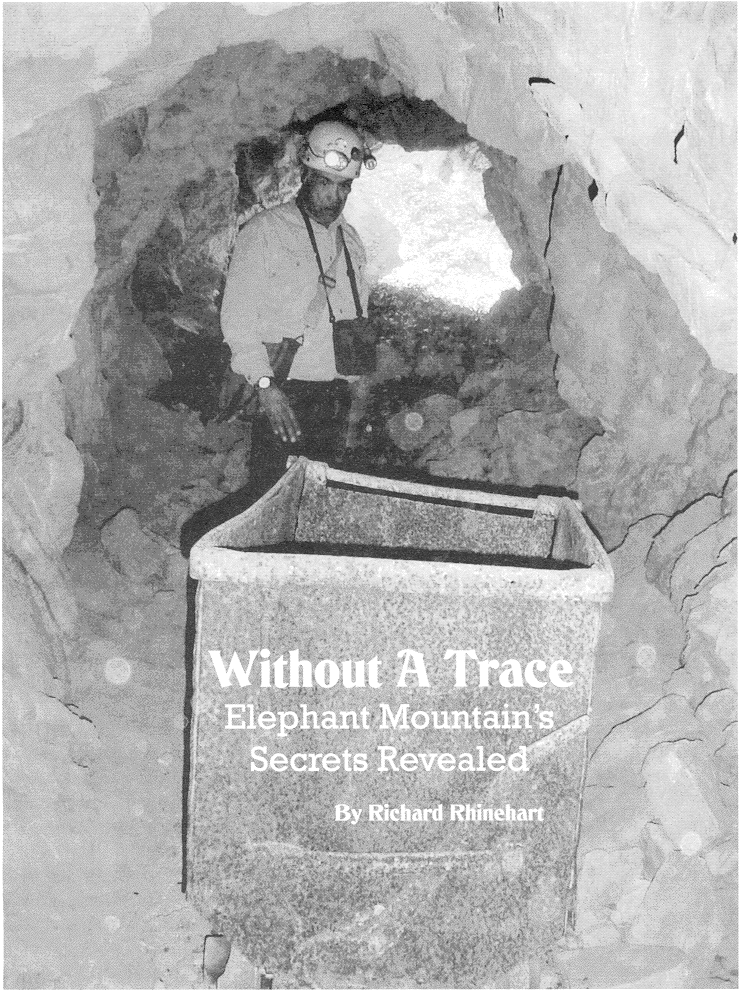
|
It is the distinctive clatter of rocks falling upon rocks that interrupts our conversation.
Momentarily taken aback, I call out to LeRoy, "that sounds good."
From the crawlway, LeRoy
backs out with unexpected speed and agility, muttering, "It isn't."
Donald G. Davis and I stare in astonishment at LeRoy, waiting for an explanation of the sound of falling rocks, which continues for a few moments
after his arrival.
"The ceiling collapsed," LeRoy finally explains, "the passage is blocked."
We are stunned. Donald peers around LeRoy, who lies in the crawl, blocking the way. "It is," he says, illuminating the
collapse with his headlamp.
Only minutes before, we were expecting to soon be collecting the remaining members of
|
|
|
our team from outside to
continue our survey of the uppermost member of a trio of mine tunnels high on the side of rugged Elephant Mountain.
An otherwise nondescript mountain in central Colorado, Elephant Mountain overlooks the scenic Crystal River valley,
which leads north from Marble past Redstone, Mount Sopris, and Carbondale.
We are guests of Robert Congdon, a former coal miner who has spent the last two decades operating mining projects in the
Pitkin County/Garfield
County region, mines that haven't always been favorites of environmental concerns and the overseeing county and federal authorities. Robert is
also a historian, having carefully studied the past mining history of the region. He fully understands why men
spent their lives in pursuit of underground wealth and prosperity.
|
|
|
|
Living in a collection of mine buildings near the mouth of Avalanche Creek, Robert today
is pursuing a dream. Developing an alabaster and building stone mine to pay his bills, Robert also has an eye on building tourism
in the area, including interpretive public visits to his mines. In his main alabaster mine, he is welcoming talented
local artists with a goal of carving into the underground bedrock a series of commanding sculptures, including
a mammoth American Eagle with outstretched wings.
Standing outside the
tunnel entrance one bright August morning, Robert points out where he plans
to build cabins where artists can spend a summer working on their art. From this growing base of operations, Robert
envisions tourists from Aspen and Glenwood Springs coming to watch the artists work, as well as embarking on trips
into his primary mine to see the underground gallery, and to Elephant Mountain to see the historic mines originally
opened by Harry E. VanDycle
in 1899.
In the waning months of the 19th century, Harry and his co-workers excavated three tunnels
overlooking the Crystal River and the Penny Hot Springs. No doubt to their surprise, their mine tunnels were unusually
warm in air temperature, perhaps owing to heat from the hot springs migrating up the sedimentary rock layers. Harry's
lowest mine, only a few hundred feet above the river, held the biggest surprise, as their mining intercepted a
series of steam-fined natural cave passages in the host limestone rock.
Detailed in the Denver Times and
other re- gional
newspapers, Harry's discovery of natural caves was a sensation. The paper reported:
"The caves are five in number, one being very large, all of them filled with magnificent
crystals and the walls hanging thick with stalagmites and stalactites, producing a beautiful and entrancing effect,
rivaling
in their splendor
anything yet discovered in this part of Colorado."
The Crystal River Railroad, with narrow gauge tracks following the river from Carbondale
to Marble, announced their intent to build a hotel, bathhouse and vapor cave facility at a new resort. Rails had reached the hot
Photo
Doug Medville examines an abandoned mining cart in the entrance of the highest mine at Elephant Mountain
south of Carbondale, Colorado.
Photo by
Mark Maslyn
|
|
|
|
- Page 1 -
|
|
springs in 1893, and tourists were beginning to discover the
scenic railroad line, which later would he advertised as "The Columbine Route."
Harry was unwilling to part with his vapor cave, however. Other
than a small bathhouse and station, no public improvements were made by the railroad company at Penny Hot Springs,
which flow from both sides of the river. Harry and his crew continued mining Elephant Mountain, opening two additional
mines above the lower~level tunnel that intersected the cave. To combat the extreme heat of the lowest miine, a
large fan was installed at its entrance, to draw cooler air through the mine like a chimney from an excavated lower-level
entrance.
In his research of the history of the mines, Robert discovered
they were worked until the Great Depression or perhaps the early 1940s. A tramway was built on the mountain to
transport ore from the upper-level mines to the railroad along the river, which then transported ore to area mills
for processing. Apparently, iron oxide was mined in the lower level mine, for use as paint pigmentation, while
precious minerals such as gold were mined in the upper mines. Transportation of ore became much more difficult
after 1930,
The scenic Crystal River Canyon south of Carbondale once contained a narrow
quage railroad. Today, Colorado state highway 133 leads to the historic mining towns of Redstone and Marble. Photo
by Richard Rhinehart
|
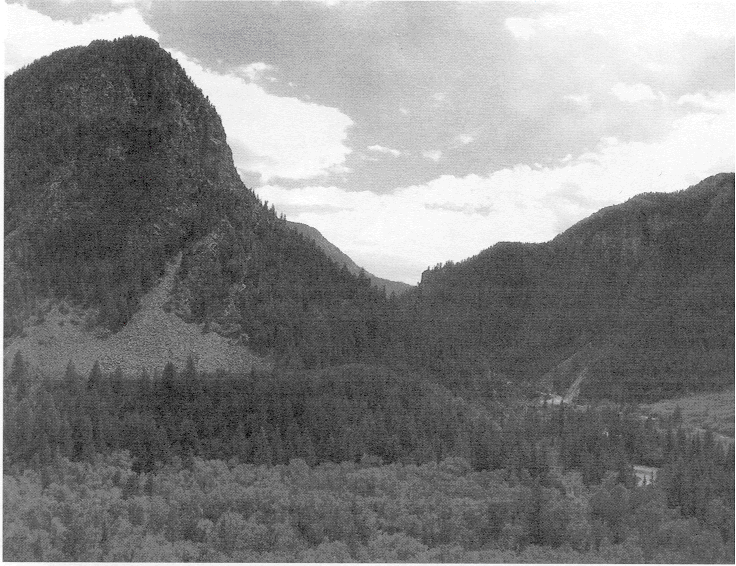 |
|
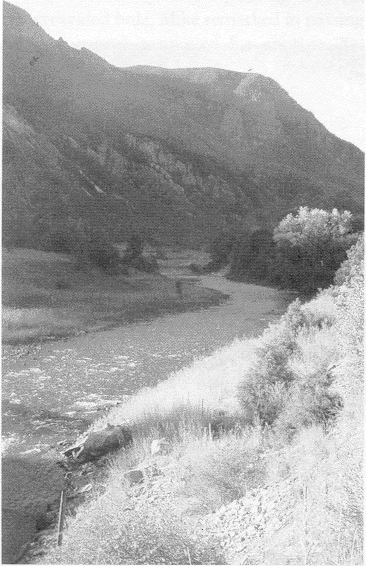
The Penny Hot
Springs along the Crystal
River included a bathhouse for tourists
in the 1890s.
Photo by Mark Maslyn
|
when the Crystal River Railroad ceased operations.
With the closure of the mines, they fell into obscurity, no
doubt helped by the departing miners backfilling the entrances to protect them from unauthorized visitation. Whether
or not the miners ever intended to return is a matter of conjecture, but they left steel tracks in each tunnel,
along with an empty ore cart on the tracks of the upper mine.
Robert's Rediscovery
Former Colorado Grotto member Lloyd E. Parris wrote about the
lost vapor cave in the lower mine in his 1973 book, "Caves of Colo- rado." Citing the Denver Times March
1899 art- icle, Lloyd concluded the mines could "easily" be rediscovered, since US Geological Survey
topographic maps indicated only two in the vicinity of the hot springs.
Accepting the challenge, Robert began walking the slopes above
the hot springs in hope of finding the lost cave and mines. On a cold winter day in 1989, he spotted a plume of
steam issuing from a small hole on the side of Elephant Mountain. Returning to his discovery with shovels and picks,
he removed six feet of backfill over several days of digging before being able to re-enter the closed mine.
Robert also reopened the middle and upper mines. In the upper
mine, Robert discovered the main passage led to an old wooden ore
|
chute, where men digging on an upper level, dumped carts of
ore to the lower level for transportation to the surface. Above the. chute, a high shaft beckoned Robert to continue,
but it was too high and too exposed to safely climb without technical equipment. Recruiting skilled technical rock
chambers for the task, the team worked for a day on the big climb. Though they promised to return to complete the
climb the next day, the climbers never returned. Tired of waiting, Robert and his brother eventually finished the
technical climb on their own, reaching the several hundred feet of passage of the upper level.
In 1993 and 1998, The Denver Post pubhshed two feature articles
about the Elephant Mountain mines, the 1998 article being published on the 99th anniversary of the publishing of
the Denver Times article about the mines and vapor cave. Clipping these articles fror the paper, 1 thought 1 would
like to someday seek out Robert and his mines, so that I might have an opportunity to examine for myself the cave
found by Harry VanDycle.
My opportunity finally arrived in August 2004, after Doug Medville
tracked down Robert and arranged for an initial visit to the mines. Arriving at Robert's in the cool early morning
hours, he described the route to the mines and confirmed we would need four-wheel drive vehicles to reach them.
For-
|
|
|
- Page 2 -
|
|
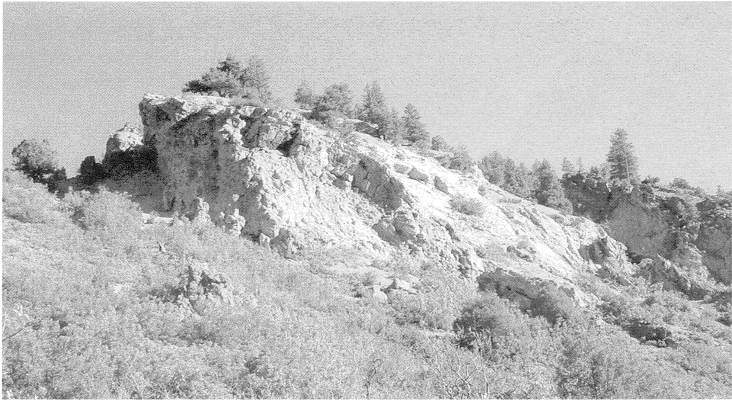
Elephant Mountain was primarily mined for iron pigment used in paint production.
The mines closed during World War II and were sealed by their owners.
Photo by Mark Maslyn
|
once again see it? The rusted steel tracks the cart was sitting
on disappeared into dirt after only a few feet. Curious, I dug into the dirt with my foot and found the tracks
were still there, though buried with about an inch of sediment that apparently had collected on the floor of the
tunnel since the miners left 60 years before.
About 150 feet into the mine, we came upon a junction. To the
left, we explored a short side tunnel that ended abruptly after only a few feet. Rusting steel pipe, wooden boards
and other artifacts were found scattered about in this corridor.
To the right, the tunnel led only 50 feet to what appeared to
be a collapse. Upon more careful examination, 1 discovered much of the debris had fallen from above, through a
still-sturdy wooden ore chute. 1 climbed up into the chute and looked up the shaft. Robert's climbing rope from
his exploration of a few years ago still is present. The shaft was too vertical to climb without aid, however,
so 1 returned to the tunnel below. On the other side of the wooden bracing for the chute, at the end of the horizontal
tunnel, 1 spotted a hidden little dome in the limestone bedrock that appeared solutional. Climbing up on a little
ledge to take a look, 1 found that the dome was natural cave and it led up six feet to a small, low room about
ten feet across. There
|
|
tunately, two of our group had brought along sports utility
vehicles that were sufficiently equipped to ford the Crystal River using an old mine access road. Doug and Hazel
Medville came along for the trip, as did Donald Davis, Mark Maslyn, Patricia Malone and Mike Frazier.
Parking our vehicles after fording the river, we started up
the steep mining road, which clearly dates from Harry's mining era. Reaching the first of the mines, we decided
to continue up the mountain, so that the geologists in our group would have a better idea of the area's basic geology.
From this point, the road was rougher and in less satisfactory condition; possibly, this was the area served by
the mining tramway, which allowed the upper road to he abandoned at an earlier date.
Reaching the broad, flat tailings pile for the middle mine we
split into two groups. One group would accompany Robert to the upper mine, while the remainder of our party would
begin excavation of the middle mine entrance. Sometime during the last three years, this tun- nel entrance was
blocked with debris washing down the mountain during a summer thun- derstorm. Robert explained the general direc-
tion of the concealed passage and took off for the upper mine.
Digging in the hard-packed dirt and rocks that choked the entrance,
we discovered the air temperature in the expanding hillside hole was warmer than the outside temperature. We understood
then that these mines and caves would contain much warmer air than a non-thermal cave at 7,800 feet in elevation.
Eventually, the others excitedly returned and we were sent on
our way up the mountain. The climb was up an eroding tailings pile
|
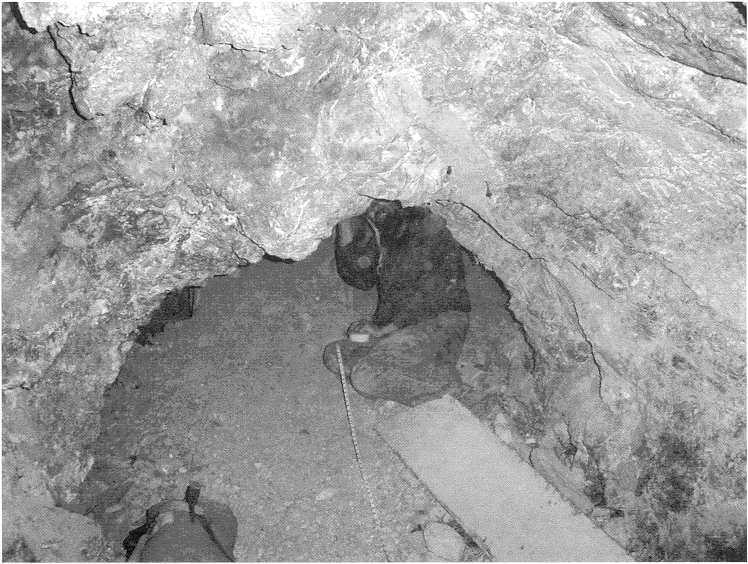
Donald Davis assists in the survey of the upper mine. This section
of the mineintersected natural cave passage developed in the limestone.
Photo by Mark Maslyn
|
|
|
|
- Page 3 -
|
|
appeared to be no passable continuation, but I did not climb
up into the chamber.
Colorado's Hottest Dig
Dropping back into the tunnel, 1 hurried back to the junction,
where 1 more closely ex- an-iined another pile of dirt and rock that ap- peared out of place. Sure enough, climbing
onto the debris, 1 could see there was a con- tinuation of the mine's main tunnel, but it had been blocked, most
likely deliberately.
I called Mike over and he took a look. He agreed it was the
"hottest" dig in Colorado and began digging in the soft, unconsofidated dirt. Within minutes, he had
a hole open to look through to what appeared to be a contin- uation of the n-iine tunnel. When he took a break
from the heat, 1 took a turn at the hole and peered through - there seemed to he much larger passage on the other
side of the debris.
When Mike was ready to dig again, 1 backed out. By this time,
Pat Malone had joined us. She helped move the dirt and occasional rock down into the larger tunnel. After only
15 n-iinutes of digging, Mike pronounced the hole large enough for entry and slipped through.
Donald Davis joined us at this point and we all settled in for
Nfike's return. He was gone for five minutes but, when he returned, he was breathless. Quickly squeezing through
the excavated hole, Mike remarked in passing that the tunnel continued for another 200 feet, ending at another
high shaft with an ore chute. Along the way to the shaft, he came upon an empty wooden dynamite box aban- doned
on the tunnel floor. He noted he was surprisingly out of breath for such a short ex- cursion, and thought he'd
head outside to re- cover from the heat.
Mike's actions seemed a little odd to us, but Donald's thermometer
on a nearby ledge indi- cated the air temperature was 67 degrees - much warmer than the expected 45-degree temperatures
found in caves and mines at a similar altitude.
Donald decided he would examine Mike's discovery and slipped
through the right spot in the dig. As soon as he slid down into the newly opened tunnel, he realized he was al-
ready out of breath. This suggested to him that Mike's anxiety most likely wasn't the heat of the mine, but the
lack of breathable air. Since the tunnel had been scaled for at least 60 years, the air was undoubtedly filled
with car- bon dioxide, possibly originating from the hot springs lower in the rock strata.
|
Concerned with the heavy concentration of carbon dioxide, Donald
climbed back up and through the dig. "Bad air," he told Pat and me.
Curious, Pat slipped through the hole and disappeared into the
tunnel. Only a minute or two passed before she was back, explaining she had followed the tunnel for about 1 00
feet before deciding to turn around. She also was out of breath, so we concluded the air in the extension was too
low in oxygen for safe exploration.
With little else to do, we headed out and re-joined our companions
at the middle mine en- trance. Mike was busy at work in the dig, seemingly forgetting we had been awaiting his
return above. He, Mark and the Medville's had been continuing the excavation, discovering small artifacts such
as rusty nails and chunks of coal in the sediment.
Our arrival allowed them to abandon their digging and head down
the mountain to the lower mine, which Robert told us contained the largest natural cave passage in the mountain.
Robert was very surprised to learn of our discovery of a hidden passage in the upper mine, particularly as he had
explored it on several occasions since reopening it over a decade ago.
Excavation of the middle mine tunnel was difficult. During our
absence, the others had lowered the floor by several feet and exposed a few air pockets. But, there still was no
clear indication where the buried tunnel lay in hiding. We only dug for a few minutes before deciding to give up
for the day. Gathering our tools, we headed down the mountain to the lower tunnel.
Into the Bat Cave
The lowest level mine is known for hosting a large number of bats. Robert reported that when he reopened the tunnel
in 1989, a number of mummified hats were discovered within. Apparently, when the workers scaled the mine, they
did so when bats were present inside. With the entrances scaled, the bats discovered they were unable to escape.
After reopening the tunnel, Robert noticed bats returned within
only a few years. Today, considerable numbers live within the tunnel and the connecting natural cave system, possibly
numbering 500 individuals. More significantly, it appears they are Townsend's Big Eared Bats, a species considered
threatened in Colorado. According to Rick Adams of the Colorado Bat Society who has examined a photograph of the
bats, the colony could be the most important for the species in the state. There are only 11 or so roosting sites
known
|
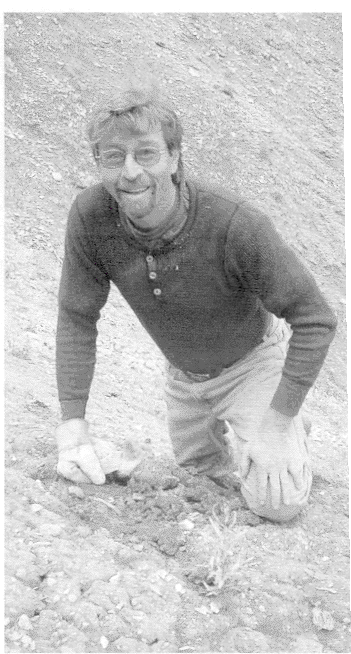
Former coal miner Robert Congdon
rediscovered and reopened the
Elephant Mountain Mines after many
years of searching.
Photo by Mark Maslyn
in Colorado, and most have fewer than 25 individuals.
Looking into the main tunnel entrance t the lower mine, I felt
a blast of beat issuing from within, even on that warm late summer day. The air has an organic smell to it, n doubt
owing to the large colony of bats that make the tunnels and cave their summer home. Robert explained that while
many o the colony leave in late September, a number of bats stay in the cave sections during the winter months.
This surprised us, as Donald recalled that the one time he had seen Townsend's Big Eared Bats wintering in Colorado,
it was on a 1958 winter trip to Hubbard's Cave in Glenwood Canyon. With its large canyon side entrances, the air
temperature in Hubbard's is close to 32 degrees yea round. Cooler temperatures make it more likely that bats will
hibernate, so we are curious if the bats in Elephant Mountain actually hibernate during the winter of if they venture
out on warm winter days. Clearly, additional study of this colony is needed.
Ducking into the tunnel, and sliding down. the surface debris,
I spotted the steel cart tracks in the floor of the passage. Elsewhere
|
|
|
- Page 4 -
|
|
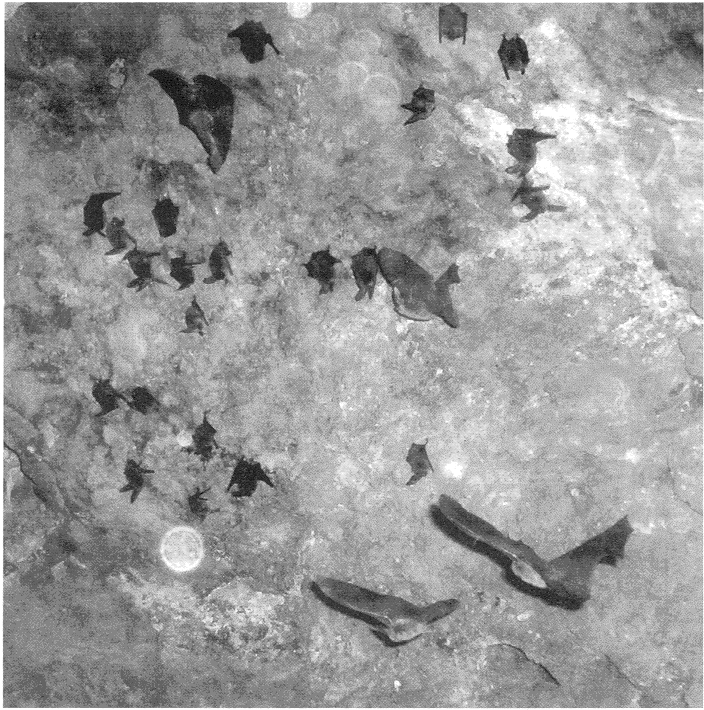
Townsend's Big Eared Bats make the lowest
mine and cave their summer home.
The large colony is easily disturbed by passing cavers so care must be taken.
Photo by Mark Maslyn
|
several minutes before disappearing quietly into a small hole).
A few weeks after our trip, Fred reported the samples are urea,
formed from calcite and urine from pack rats. It has been previously reported in Israeli and Western Australian
caves in crust and stalagmite forms, but not in flowstone and draperies. The discovery in Elephant Mountain may
be the first reported occurrence in the New World.
Leaving the colorful display, we met Robert at the junction
with the natural cave passage. He suggested that we take a look at the descending cave passages, which lead to
several natural rooms and chambers below, as well as additional rnined tunnels. Donald, Mike and Pat accepted Robert's
offer and were off at once, their voices fading into the distance.
I lingered with Robert for several minutes at the cave junction,
discussing his ideas for possible development of the property for commercial wild caving tours. Robert admiitted
he is concerned with the impact the tours might have on the bats that make the mine their home, and thought he
might limiit tours to the winter months. Alternately, he wondered if he could install a closed-circuit television
camera that visitors might turn on to see the bats from an outside tour center. Since our pres- ence continued
to upset the bats, we reluctantly made our way to the surface, where we awaited the return of our caving companions.
|
|
in Colorado, during steel drives during World War 11, local
citizens removed tracks from abandoned mines and railroad grades to help in the war effort. No doubt, these mines
were completely sealed before such drives began.
Reaching a junction in the tunnel, we noticed natural cave intersected
the tunnel from below. There are several short side tunnels at this point, and 1 noticed each was filled with one
or more large flying Townsend's Big Eared Bats. These bats fluttered about as our lights played over the tunnels.
Some would fly toward us, but each would turn back before getting too close. 1 hadn't seen anything like this in
my previous Colorado caving, the only comparable experience was during a 1980s Cave Research Foundation trip into
Carlsbad Cavern, when Donald, Barbara am Ende and I watched the famous bat flight from inside the cave.
Not far from the natural cave passage, a side tunnel led past
some old wooden scaffolding, and dead ended with more flying bats swooping from their ceiling perches and making
it unappealing to continue. All of us were amazed and delighted, however, with a unique
|
collection of canary yellow flowstone and draperies found on
one wall. While not particularly large, the color of the dripstone and flowstone was stunning. None of us had seen
anything like it elsewhere.
Guessing the canary yellow color had to do with local organics,
we secured permission from Robert to take a few small samples for Fred Luiszer to analyse at his University of
Colorado geological laboratory. One possible clue was the numerous pack rat urinary trails 1 spotted on the wall
near the colorful formations. On previous trips to various White River Plateau caves, Fred and I had spent hours
identifying the unique trails constructed by pack rats that they follow by smell through totally dark corridors
and passageways. Fred told me the trails are very common, yet not fully studied by biologists. Clearly, the well-defined
trails in the lower Elephant Mountain mine indicate pack rats fully take advantage of the mines' warm air temperature
(on a later trip to the lower mine's canary yellow formations, we spotted a bushy-tailed pack rat watching us from
high on the wall; surprisingly brave, the rodent watched us for
|
Outside in the late afternoon sun, Robert showed me the lower
entrance to the lower mine, a sinkhole-like opening in the hillside not far from the main tunnel entrance. The
opening of the lower entrance helped cool the passageways within, Robert explained, as the lower entrance allowed
a chimney effect to circulate air.
Sitting at the lower entrance, I soon heard the voices of Mike
and Donald. Leaning over the vertical hole, I encouraged them to make their way out of the mine. Mike reported
the passage was nearly blocked with debris, how- ever. We dropped down to him an old shovel blade 1 found on the
hillside, which he used to clear some of the leaves and dirt that had filtrated down into the tunnel. At one point,
I could see his hands, but he reported the squeeze was a little too tight. And then they were gone, their voices
fading away.
It was nearly ten minutes before Donald, Mike and Pat appeared
at the main tunnel entrance. Donald told us that the natural cave passage descended steeply intersecting excavated
mine tunnels. At one point, a wooden handmade ladder provides access down a sharp chimney to the lower level. At
another point, they followed a passage into a sizable
|
|
|
- Page 5 -
|
|
room where a large number of bats roosted. Robert reported this
was the main colony chamber, which usually is one of the warmer rooms in the complex, probably owing to the body
heat of the bats supplementing the warm air temperature. The group hadn't ventured far into the colony chamber,
as the bats immediately became agitated at their presence.
Robert reported there are several possible digs in the lower
levels, possibly locations where the original miners had buried natural cave passages that emitted warm air. It
is his hope to someday excavate these buried leads in search of additional passageways and even hot water at lower
levels. Robert said temperatures in some of the lower passageways exceed 90 degrees; on a later survey trip, Donald
measured a temperature of 78 degrees not far from the urea flowstone in the mine's upper level.
The Trouble With Harry
It was five weeks before we could return to the mines. Summer
had turned to autumn and the aspen leaves in the Crystal River Valley were brilliant yellow, red and orange. On
our second trip to Elephant Mountain, Fred Luiszer, who was intrigued with our stories and wanted to see these
unique mines, joined Mark, Donald and me.
As Donald, Robert's brother-in-law LeRoy, and I dig at the "hottest"
dig in Colorado in the upper mine, Fred, Mark and Robert head outside for a look at the geology of the area. From
the mine entrance, they climb up the mountain, to high outcrops and old mine en- trances Robert had previously
investigated. Mark discovered through geological research that the limestone in which the mines and natural caves
are found is a unit of the Pennsylvanian age Eagle Valley Evaporates. The region near Elephant Mountain is faulted
and distorted by geological uplifts, as well as altered by Tertiary-age igneous bodies. Some of the rock strata,
such as that found in Robert's main n-mine on Avalanche Creek, has been metamorphic ally changed into alabaster
and decorative stone.
The Penny Hot Springs in the Crystal River valley below the
mines are not from intrusive igneous bodies, however. Rather, the water is- suing from the springs is heated much
like the water issuing from the Glenwood Hot Springs - from deep circulation tens of thou- sands of feet below
the surface. The gypsum and limestone of the Eagle Valley Evaporates allows for the easy circulation of this water
from its infiltration point to its recharge in the Crystal River valley.
|
In our dig, we are not considering circulation of the water
in the Penny Hot Springs. Following the frightening collapse of the ceiling of the tunnel, Donald squeezes carefully
into our dig to see what can be done to re-open it for safe passage. Having participated in countless cave dig
projects with Donald in the past, I can tell by his voice that he is concerned - the ceiling of the tunnel appears
to be very unstable, with no safe way to remove the big rocks that have fallen.
One rock is particularly troublesome, having fallen directly
in the excavated hole that we had been working on to make the squeeze more comfortable. It is large - probably
four feet by two or three feet across - and we don't have the gear needed to pull it out of its resting spot. Donald
speculates we'll need to have a come-along winch to tug it out and pull it down into the main tunnel. But, he's
not sure that by doing so that the tunnel will be safe to traverse,
or even passable.
Donald backs out of the collapse zone with care and LeRoy shows
no inclination to return. I offer to take a look and, as soon as I slide into the crawl, I can see why LeRoy is
reluctant to return. Above me, I can see that there are numerous rocks held in place by only the big slab that
fell, nearly crushing LeRoy except for his quick retreat. The hole to the open corridor that Mike had traversed
five weeks before was gone, completely blocked by debris. If I didn't know the passage continued, I would never
guess this was not a terminal collapse.
Donald speculates the original blockage that Mike, Pat and I
had excavated on our earlier trip was not artificial, but represented an earlier collapse episode. In looking over
the unstable ceiling, I tend to agree, but suspect the miners had backfilled the passage after the collapse. Indeed,
on the fill at the entrance of the dig, we had found a board with the hand-written inscription "Harry"
on it.
Examining the board, Robert speculated that the inscription
was in regard to Harry VanDycle, the 1899 miner who owned and managed the mines.
Curiously, earlier in the day, while we completed our survey
of the upper mine except for Mike's new discovery, Robert had decided to investigate the hidden passage on his
own. Sliding into the crawl way, as he reached the tight discovery hole, his Wheat Lamp sud-
|
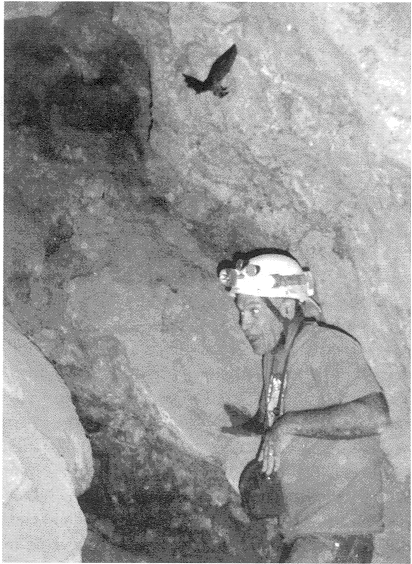
A low flying bat convinces Doug Medville
that it is time to leave the lower mine.
Photo by Mark Maslyn
denly went out, plunging him into darkness Backing out the crawl
way by feel, he found he could not get his light to turn on again. I provided him some fight while I worked on
my survey book sketch, but he decided he would go outside to see why his light had failed. He could see the entrance
portal in the distance and headed out alone.
Here's where it gets odd - outside, in the sunshine, Robert
finds his Wheat Lamp is in perfect working order. There are no problem with the battery, the cord or the light
bulb 9 he had thought inside. It simply failed just 9 he was preparing to slide into the open pa, sage beyond our
dig.
Minutes later, as LeRoy is digging at the floor in preparation
to climbing down into the walking corridor, he suddenly is aware of tin amounts of dirt falling from above. Aware
c his precarious position, he decides to back out of the squeeze and moments later the rock begin falling.
1 can offer no explanation for these event in the upper Elephant
Mountain Mine, which we call "Upper Decker" after the origin, mining claim name. It's certain, however,
th2 if Robert or LeRoy had been beyond in the corridor beyond the squeeze when the rock came crashing down that
we would have had major rescue on hand.
Was Harry watching over us that autumn morning?
|
|
|
- Page 6 -
|
| Copyright (C) 2005 Rocky Mountain Caving. All Rights Reserved |
| Back to the Elephant Mountain Caves Main Page |







